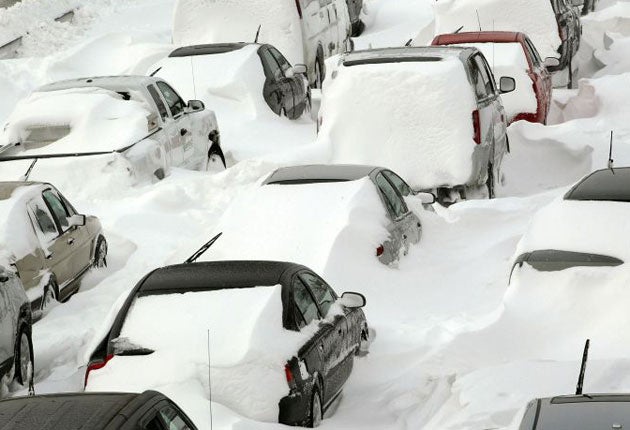Your support helps us to tell the story
From reproductive rights to climate change to Big Tech, The Independent is on the ground when the story is developing. Whether it's investigating the financials of Elon Musk's pro-Trump PAC or producing our latest documentary, 'The A Word', which shines a light on the American women fighting for reproductive rights, we know how important it is to parse out the facts from the messaging.
At such a critical moment in US history, we need reporters on the ground. Your donation allows us to keep sending journalists to speak to both sides of the story.
The Independent is trusted by Americans across the entire political spectrum. And unlike many other quality news outlets, we choose not to lock Americans out of our reporting and analysis with paywalls. We believe quality journalism should be available to everyone, paid for by those who can afford it.
Your support makes all the difference.A fearsome storm has spread a smothering shroud of white over nearly half the US, snarling transportation, burying parts of the Midwest under 2ft of snow and causing at least 12 deaths.
Tens of millions of people stayed at home. The hardy few who ventured out faced howling winds that turned snowflakes into face-stinging needles. Chicago's 20in of snow was the city's third-largest amount on record.
The storm that resulted from two clashing air masses was rare for its size and ferocious strength.
"A storm that produces a swath of 20in snow is really something we'd see once every 50 years - maybe," National Weather Service meteorologist Thomas Spriggs said.
Across the storm's path, lonely commuters struggled against drifts up to 4ft deep in eerily silent streets. Parkas and ski goggles normally reserved for the slopes became essential for getting to work.
Although skies were beginning to clear by mid-afternoon over much of the country's mid-section, the storm promised to leave a blast of bitter cold in its wake. Overnight temperatures in northern parts of the Midwest were expected to fall as low as minus 30C, with wind chills dropping to minus 35C.
The 12 fatalities included a homeless man who burned to death on New York's Long Island as he tried to light cans of cooking fuel, and a woman in Oklahoma City who was killed while being pulled behind a truck on a sledge that hit a railing.
Airport operations slowed to a crawl across the US, and flight cancellations reached 13,000 for the week, making this system the most disruptive so far this winter. A massive post-Christmas blizzard led to about 10,000 cancellations.
In the winter-weary north east, thick ice caused several structures to collapse, including a filling station canopy on Long Island and an airplane hangar near Boston. In at least two places, workers heard the structures beginning to crack and narrowly escaped.
More than half a dozen states began digging out from up to a foot of snow that made roads treacherous and left hundreds of thousands of homes without power.
Chicago schools cancelled classes for a second straight day, and the city's iconic Lake Shore Drive remained shut down, nearly a day after drivers abandoned hundreds of snowbound vehicles.
Elsewhere, utility crews raced to restore power to many thousands of homes and businesses in Ohio, New Jersey and Pennsylvania, where freezing rain and ice brought down electrical lines. Rolling blackouts were implemented across Texas, due to high demand during a rare ice storm.
In Canada, heavy snow cancelled about a quarter of the 1,200 scheduled flights at Toronto's international airport, closed schools, and caused dangerous driving conditions due to drifting snow.
The storm derived its power from the collision of cold air sweeping down from Canada and warm, moist air coming up from the south.
The contrasts were most dramatic in Texas earlier in the week, when one part of the state reported temperatures below freezing and another part had temperatures around 20C with near-tropical humidity.
Louis Uccellini, director of the government's National Centres for Environmental Prediction, said the storm also drew strength from the La Nina condition currently affecting the tropical Pacific Ocean.

Join our commenting forum
Join thought-provoking conversations, follow other Independent readers and see their replies
Comments